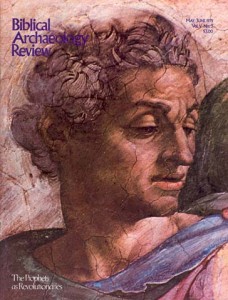Biblical Archaeology Review, May/June 1979
Features
The Prophets as Revolutionaries: A Sociopolitical Analysis
Five Biblical prophets—Amos, Hosea, Micah, Isaiah and Jeremiah—scathingly attacked the sacrificial cult practiced in the shrines of ancient Israel and Judah. These prophets all lived in that turbulent 150-year period that began with the death-pangs of the Kingdom of Israel in the late 8th century B.C. and...Read more ›
Plants as Biblical Metaphors
For our ancestors, wild plants and animals of the Holy Land served as symbols and metaphors. These people were closer to nature than we are today and they understood the life cycles of the plants and animals about them. In the Bible, they used this knowledge in...Read more ›
The Hebrew Origins of Superman
Using well-established principles of form-criticism, as well as the findings of Biblical archaeology and other methods of modern Biblical scholarship, I have discovered that the Superman stories—commonly thought to be of purely American origin—are in fact rooted in ancient Hebrew institutions. The well-known folk tale centers on...Read more ›
The Evolution of Two Hebrew Scripts
Paleo-Hebrew or Phoenician script was used before Aramaic script was introduced by Jews returning from Babylonia.
In BAR’s version of Superman’s original costume, pictured in “The Hebrew Origins of Superman,” in this issue, Superman the scribe wears the Hebrew letter samekh on his chest. But even people who know how to read modern Hebrew—as it is printed in Israel as well as in...Read more ›
Excavations at Tell Mevorakh Are Prelude to Tell Dor Dig
What a daughter site can tell us about its mother
In 1980, the first spade will sink into Tell Dor. As previously announced in BAR (“Yigael Yadin to Head New Excavation,” BAR 04:04), I will direct the field work at the new excavation. In a sense, however, this excavation began several years ago at nearby Tell Mevorakh...Read more ›
How the Blind See the Holy Land
As every blind person knows, he can “see” what he can touch. Archaeology, the study of the material remains of ancient cultures, can be touched and therefore “seen” by the blind. Two experimental programs applying this principle have been developed by BAR’s Jerusalem correspondent, James Fleming, to...Read more ›
More Digs in ’79
Volunteer Opportunities at Tell el-Hesi and Tell Yoqne’am
Two important excavations with volunteer opportunities were omitted from the listings in our March/April issue. The Tell el-Hesi Archaeological Expedition, patriarch of digs, will be in the field for its sixth season, June 14 to July 31, 1979. Tell el-Hesi is one of the most famous sites...Read more ›

